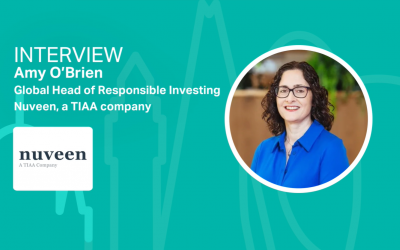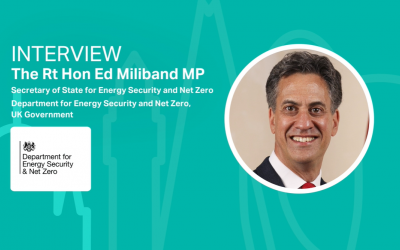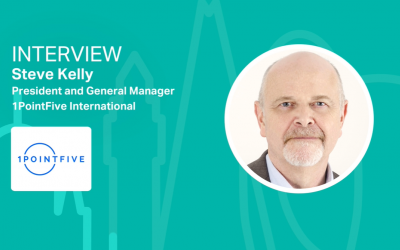Dr. Oliver Marchand on what MCSI is doing to help investors transition to net zero
After the Sustainable Innovation Forum 2021, Climate Action caught up with Dr. Oliver Marchand, Global Head of ESG and Climate Research & Development at the MSCI Climate Risk Center, to discuss what MCSI is doing to help investors transition to net zero.

After the Sustainable Innovation Forum 2021, Climate Action caught up with Dr. Oliver Marchand, Global Head of ESG and Climate Research & Development at the MSCI Climate Risk Center, to discuss what MCSI is doing to help investors transition to net zero.
As we approach the final days before COP26, what is one key thing you believe is critical to be done over the course of the next decade?
I think it’s critical that countries form a 2°C-aligned, or if possible, a 1.5°C -aligned plan to reduce emissions through their nationally determined contributions, or NDCs. The current NDCs are at a 2.4°C to 2.6°C level, which is simply not sufficient. We need to do two things as a global community: To create these NDCs that are 2°C and 1.5°C-aligned. And then comes the hard part: We need to put those plans into reality and really make them work.
Our MSCI Net-Zero Tracker shows that the annual emissions of listed companies are still at 2013 levels, even though in the past eight years there has been a concerted effort to place climate change at the top of the global agenda. What does that mean in practice? Listed companies would need to cut their carbon intensity by about 10% each year between now the year 2050 to limit global warming to 1.5°C. That is a monumental task but it’s what we have to do.
What can investors and companies be doing to up the urgency?
They can first look at and analyze their investments. The three most important dimensions to analyze are exposure to climate change, impact on climate change, and risk levels with respect to climate change. Once they've done the analysis, they have a number of strategies at their disposal. One is reallocation of capital to the decarbonizing companies and away from those that are moving too slowly or not acting at all. Another one is engagement with companies - they can put pressure on boards and management to transform their business models. And the third one is working with regulators and other stakeholders on better reporting and better metrics.
There is also a need for companies to transition their operations, products and services to a net-zero business model as quickly as possible. All companies need to set emissions-reduction targets covering both their direct and supply-chain emissions, as well as those caused by use of their products.
Overall, it’s a complicated task. If we say, for example, that the five most important sectors that need to decarbonize over the next 30 years are real estate, energy, production, transportation and food – then each of these sectors is a decarbonization world by itself. We need to employ all solutions available to succeed with the transition to a net-zero world.
What is MSCI doing to support the transition? What do investors need in this net-zero revolution?
We have a large set of metrics and tools available for investors to work with. It starts with collecting data on companies’ targets and carbon footprints, analyzing portfolios based on their carbon footprint and risk levels, modeling transition and physical risk – all the way to very complex temperature alignment metrics, so that we can actually determine the temperature of a portfolio.
We have just launched our newest version of implied temperature rise. We equip investors with the implied temperature rise of nearly 10,000 listed companies to determine the alignment of their portfolios with global temperature targets. We are also proud to be a leader in ESG and climate transparency. So, ahead of COP26, we have made the implied temperature rise of over 2,900 listed companies, the constituents of the MSCI ACWI Index, publicly available on our website.
Why is this an important metric? Why do you think it will be significant?
We believe Implied temperature rise is an important metrics when it comes to looking at investments and climate change. Because the overall goal of climate change mitigation is to limit global warming, and that is a question of emissions and temperature. Implied temperature rise is designed to be aligned with this objective. It also speaks best to most people without the need to go into a long explanation of risk models or emissions levels. Everybody sort of understands that a portfolio temperature of 1.5 degrees is much better than 6 degrees. So it's the relevance and the user friendliness of the metric that makes it so interesting.
We expect that implied temperature rise metrics will be at the top of the agenda at COP26, and in the best case might even make it directly into the Paris Agreement as a proposed tool for investors to employ.
How did you integrate sustainability into your career path, and why does this topic hold such meaning to you personally?
In my academic studies, I studied computer science and meteorology. So I was in a unique position to have heard about climate change in the year 1992 already. This was long before Al Gore’s well-known movie “An Inconvenient Truth,” which made the broader public aware of climate change. I've been following the debate for three decades! Then, 15-20 years ago, when it became crystal clear that climate change was a major crisis, I wanted to be part of the solution. So I used the skills that I had to think about what the best leverage that I could have to help with this global issue.
Reproduced by permission of MSCI ESG Research LLC ©2021. All rights reserved. No further reproduction or dissemination is permitted.
MSCI are speaking at the Sustainable Innovation Forum 2021, to join them register here now.


_400_250_s_c1.png)



